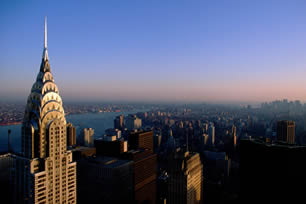Wall Street
The very heart of New York's financial center and the historic site of George Washington's inauguration.
Wall Street takes its name from the original 1653 Dutch-built wooden stockade, constructed for protection from the invading British colonies. Although dismantled in 1699, the name remained. Establishing its very first trading systems in the 18th century, the area grew to become the ultimate international financial centre of the 20th century.
Wall Street's banking heyday is now over as, after 9/11, many banks closed and moved to varying city locations, to be replaced by gyms, apartments and shops. However, the area continues to be the home of the New York Stock Exchange, and therefore, at least for now, remains the apex of global finance.
The neoclassical facade of the stock exchange on Broad Street, is impressive, but perhaps it should be clad in gold to reflect the fact that around $50 billion is traded daily within its walls. The building is closed to visitors, but its exterior can be viewed easily from its front pedestrianised area.
Just north of the stock exchange, the bronze figure of George Washington stands outside the fine Greek Revival architecture of the Federal Hall National Memorial. It was on this spot, in 1789, that Washington was inaugurated as America's first president. Back then it was City Hall, but this was knocked down in 1812 and a new building was constructed in 1836, symbolizing the country's democratic ideals .
Further along Wall Street, the former home of the Bank of New York is now the Museum of American Finance, helping to demystify the trading industry (as much as it can be demystified) and for viewing rare artefacts, including a length of ticker-tape from the opening moments of the Great Crash of 1929.
On Broadway, at Wall Street's western end sits the third version of the petite Trinity Church. Originally built in 1698, today's neo-Gothic version was constructed in 1846. Dwarfed by taller, more modern buildings on each side, this little place was once New York's tallest building.
Another example of neo-Gothic architecture can be seen in the Trump Building (40 Wall Street). This 70-storey skyscraper, completed in 1930, was famously part of the race for the title of world's tallest against the Chrysler and Empire State buildings. At 927 feet, the Trump Tower was surpassed (or indeed trumped) by both the Chrysler Building (1,046 feet) and the Empire State Building (1,454 feet). Originally the headquarters of the Bank of Manhattan it was renovated in 1996 by Donald Trump, the American business magnate, after which it is now named.
The wider Financial District has many gems to explore. These include the historical: The Battery; the National Museum for the American Indian; the Fraunces Tavern Museum and Stone Street, to the amusing and bizarre: the McDonalds on Broadway, where real orchids grace every table and musicians perform on a grand piano as well as the Charging Bull Statue, representing a bull (constantly rising) market, and for those inspired by the money changing hands at the stock exchange, the very popular designer discount store Century 21 on Cortlandt Street awaits.




